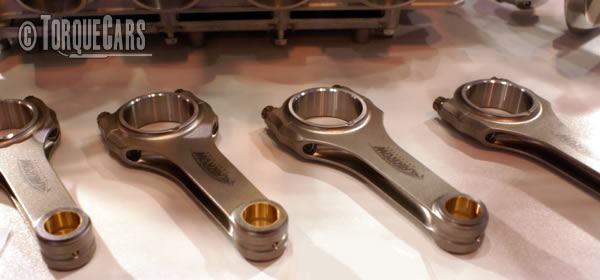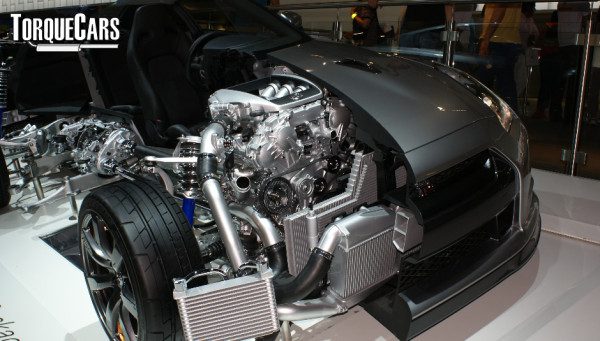Best Performance Conrods
"A Guide to Selecting Connecting Rods for a Performance Engine."
A performance engine requires optimum designed internal pistons, crankshafts and of course high performing conrods.
As a piston produces pushing and pulling forces needed to move the conrod and rotate the crankshaft, it is important to choose the right design and style for your setup. We will go into detail on the different types and choosing the right conrod for you.
What is a conrod?
A connecting rod (conrod) is an internal component in piston engines. Connecting the crankshaft to the piston. The crankshaft with the conrod converts the interchanging motion of the piston into rotational motion for the crank shaft.
A conrods job is to convert power (or reciprocal movement) into rotational force. Without a conrod, a traditional internal combustion engine would not function.
It is assembled by fitting the big end onto the crankshaft using a slide bearing mounted to the crank pin.
The small end houses the piston pin and includes a bearing bushing. An oil duct is normally drilled through the conrod, resulting in the pistons being lubricated.

Tensile Loads, Compressive Loads & Inertial Forces
The conrod transmits the compressive and inertial forces from the piston as it rotates and pivots at both ends, spinning the engine's crankshaft.
It enables the engine to output the rotational force to drive the transmission and eventually the driveshafts and wheels.
A tensile load is force being pulled lengthways on a component. A compressive load is the opposite, a pushing force inwards onto the component. Inertial forces are forces exerted on a moving component across a circular path, sometimes referred to as centrifugal force.
So the conrods will stretch and compress in everyday loads.
Eventually, the metal fatigue caused by vibration, stretching and contracting and heat, or stress fractures that were inherent during the manufacturing processes, will manifest themselves as a failed conrod.
The conrod needs to cope with this stretching and compression, vibration and heat from the engine, so there are many considerations in choosing a material for your conrods.
Flexible or Strong is the tradeoff here you need to be somewhere between these two extremes and it depends on the engine design, whether it is a short or long throw block and even the configuration of the cylinder layout.
The way the rods are designed, forged and treated during manufacture will greatly affect the properties of the rod.
So we can't just make a sweeping statement that you need a really hard steel, or very strong conrod, as this would not be ideal in some applications, where longevity and the rotational forces need to be taken into account.
Types of conrod design
There are two main choices when choosing appropriate conrods, they are I beam and H beam setups and are explained below.
Thanks to the complexity of modern production and raw material selection these generalizations have become rather blurred, but are still viewed as a rule of thumb by many tuners.
I Beam
Very strong appearance, with a wider profile. They are easier to produce than H beams as they are simpler to machine.
They are used on stock engines and if the same material and length were factored in, compared to a H beam they would be considered lighter.
H Beam
A H beam setup is named because if you cut a cross section along the main shaft, it looks more like a H.
With much bigger, flat sides that form across the length of the rod, with the centre section being much narrower.
They are much more expensive to machine but offer better performance in high power, high torque applications.
Materials and processes
Steel titanium and alloys
A lot of different materials are used in conrods, along with different processes to manufacture them. Including carbon steel, graphite cast iron, micro-alloyed steel and iron based sintered metal.
In most high-performance applications, a machined billet is used to produce a conrod.
Whereas in common road cars the conrod is made from casting or forging steel.
Aluminum alloy is another type of material that is excellent for weight reduction and can be machined from a billet of stock material.
Aluminum tends to have a strength of 97,000psi so about half that of steel, but the reward is a much lighter rod (about 30% of that of steel), allowing higher RPMs and faster rev changes. Due to the low weight, you can use more material to compensate for the strength.
Aluminum has greater elasticity and absorbs a lot more shocks and vibrations, enhancing the longevity of the engine. However, it is more prone to degradation from heat and will not last as long as other materials in a race-spec engine.
It also expands more but does so more quickly, so it becomes more important to warm up the engine before driving hard on it as parts are machined for optimum high temperature clearances, resulting in much higher clearances when it's cold.
The customization aspect of a machined part is why they are used.
As with casting and forging, expensive dies need to be manufactured and only have a certain lifetime. Titanium can also be used as conrod material, which is extremely lightweight but much more expensive.
Steel is not just Steel - the many options
There are many different types of steel around, and it tends to be graded by nimber which reflects the makeup of the steel. The tensile strength of steel is in the order of 200,000psi depending on the grade and processes used on it.
The primary two numbers show the steel used, so a 43XX usually has Nickel and Molybdenum in it whereas a 51XX does not.
The second two digits show the carbon content, which tends towards a stronger steel so an XX40 has .40% of carbon.
For example, a cheap to produce budget steel at 5140 would be a good option for a manufacturer wanting to keep costs down, but in a performance engine where heat and stresses are much higher investment will need to be made in sourcing a performance alloy of steel with a high-carbon content so typiucally a 4340 or 4330 grade of steel.
Various heat treatments, cooling, heating, cryo treating and similar processes will also affect the characteristics of the steel and its suitability in your application.
Forging, Casting and Machining
Forging is the process of heating a blank piece of metal to high heat, enough for it to be malleable.
Then this material is forced into a die at high pressure. Machining processes then finish the component to the correct dimensions and surface tolerances. Think of a blacksmith beating a hot piece of metal into
Casting is similar, except molten material is poured into a mould, usually made from sand that is separated once cooled.
Casting leaves a dividing line between the two halves of the component where the join in the mould meets.
Machining is the process whereby a CNC machine uses diamond tipped cutters and a rotating robotic arm or drill to machine away layers of the material. Producing a conrod from a single block of metal.
Casting is cheaper and doesn't result in a good grain structure, so it's not a good option for performance engines.
Forging ensures an excellent uniform grain structure, and this structure "flows" around the big end of the conrod, adding around 20% to the strength
Machining a rod ensures the rod has the grain structure of the parent it was cut from, it also produces a very smooth surface and this has benefits at reducing friction and drag.
Pros and Cons for Strength
For high strength applications in a high-performance setup, steel is considered less desirable.
Due to the traditional manufacturing methods, they are difficult to re-design and optimise for performance. But can be mass produced easily and are suitable for lower power.
Titanium conrods are excellent for strength and for long lasting race setups. Whilst offering the best all-rounder for lightweight design.
However, titanium is the most expensive material choice.
The fatigue element is important to consider with titanium, as in racing applications they need to be switched out after 40-80hours typically.
Aluminum is usually made from extrusion processes, where the heat treatment and stress relief has taken place.
Resulting in a more stable rod, which can be machined to any number of designs and iterations to produce the best version for your application.
The cost is lower than titanium too. Aluminum is less durable in track race applications as it absorbs a lot of shock that reduces the load on the crank shafts. This results in a lot of flexing and a reduced lifetime on the engine.

Pros and Cons for Weight
The H beam conrod is generally better at minimizing compression forces on charged engines. Because of their lightweight design using less material, charged engines are more susceptible to bending, because the forces exerted on them are not linear.
An I beam conrod is often considered heavier but advances in design and manufacturing methods mean this assumption does not hold true.
Their lightweight design can be optimized if more machined processes are introduced. Often sustaining up to 1,000 horsepower because of their more robust manufacturing processes, and high strength steel setup.
Ultimately, a lot of factors determine the life and material choice of the best conrod for your application.
For drag racing performance, an Aluminium rod offers a lightweight and low-cost solution for short runs.
For high-end track motorsport, titanium is the upgrade to this.
Whereas steel is a foundation for long lasting material for lower power performance applications and is easier to mass produce.
Please join us in our car forums to discuss all aspects of your cars build, please share your project with us, and feel free to pass on any tips or comments so that we may continue to improve this article.
Please Check out my YouTube channel, we're regularly adding new content...
PLEASE HELP: I NEED YOUR DONATIONS TO COVER THE COSTS OF RUNNING THIS SITE AND KEEP IT RUNNING. I do not charge you to access this website and it saves most TorqueCars readers $100's each year - but we are NON PROFIT and not even covering our costs. To keep us running PLEASE Donate here
If you liked this page please share it with your friends, drop a link to it in your favourite forum or use the bookmarking options to save it to your social media profile.
Feedback - What do You Think?
Please use our forums if you wish to ask a tuning question, and please note we do not sell parts or services, we are just an online magazine.
Help us improve, leave a suggestion or tip
Please watch this video and subscribe to my YouTube channel.

 Click to accept YouTube Cookies & Play.
Click to accept YouTube Cookies & Play.